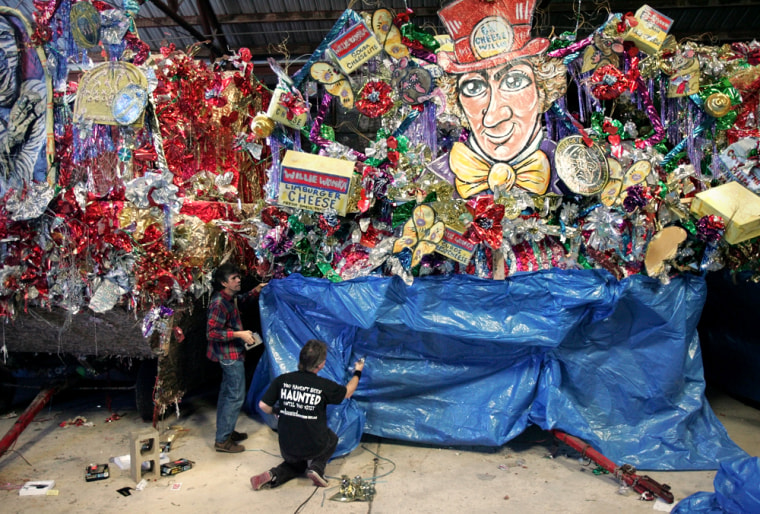The first Mardi Gras parade since Hurricane Katrina marched Saturday evening through the French Quarter pulling carts with blue tarps, effigies of Mayor Ray Nagin and Gov. Kathleen Blanco and floats with themes such as “Give Me That Mold Time Religion.”
The Krewe du Vieux lampooned Katrina and public officials blamed for the bungled response to the catastrophe in their parade themed “C’est Levee,” a play on the French phrase meaning “that’s life.”
Mardi Gras has long been an occasion for the city to laugh at tragedy and aim barbs at authorities. Given all the pain New Orleans has suffered in the past year, the irreverence should reach new heights this season.
“It is hard living here now. We need to have our opportunity to release,” said organizer Keith Twitchell. “If you don’t laugh, you’re dead. There’s a lot to cry about here.”
One display asked France to buy Louisiana back, suggesting the state might get better treatment than it has from the American government. Another float was themed “Fridge Over Troubled Water.” In place of a parade map, the Krewe du Vieux had a “projected path” adorned with a swirly hurricane symbol.
Amid revelry, absent friendsStill, in the midst of revelry and satire, even the city known as the Big Easy has a serious side.
The Zulu Social Aid & Pleasure Club, a 90-year-old historically black group that holds one of the city’s most beloved parades, held a service and lit 10 candles in honor of club members who have died since the storm. An eleventh was lit to honor the hundreds of people killed by Katrina.
Mardi Gras parades typically run on weekends leading up to and on Mardi Gras, which falls on Feb. 28 this year, almost exactly six months after the Aug. 29 storm. The parades are put on by private clubs across the city; Krewe du Vieux is a smaller French Quarter parade that runs in advance of the major parades.
Masked riders in the parades have long used the opportunity to mock the ruling class and government officials, said Mardi Gras expert Arthur Hardy. The tradition goes back to 1873, when the Mistick Krewe of Comus themed its parade “The Missing Links to Darwin’s Origin of the Species” and portrayed Union Gen. Ulysses S. Grant as a tobacco grub.
‘Laugh to keep from crying’Hardy said the satire serves as a coping mechanism. “It’s almost like you laugh to keep from crying. It’s a chance to say ’This can’t keep us down,”’ he said.
Even groups that are typically less tongue-in-cheek are taking swipes at the storm and politicians this year.
The Krewe of Carrollton, which holds its parade on Feb. 19, chose the theme “Blue Roof Blues” — a reference to the tarps protecting damaged and leaky roofs. The Krewe of Mid-City will use blue tarps along the bottom of its floats — in part out of necessity because of flooding at its warehouse.
Bitter slice of ‘American Pie’The Mid-City parade, scheduled for Feb. 26, will have floats called “New Orleans Culture” — that’s culture as in mold — and “I drove my Chevy to the levee but the levee was gone,” a bitter twist on the line from Don McLean’s “American Pie.”
It will also use a float from last year’s parade that bears the image of Willy Wonka. The “Charlie and the Chocolate Factory” character has become a favorite reference to the mayor since he angered residents by saying New Orleans would once more become a “chocolate city.” New Orleans was more than 60 percent black before Hurricane Katrina displaced about three-quarters of its population.
“As fate would have it, we’re able to recycle it,” Gerard Braud, a former Mid-City king, said of the float.
